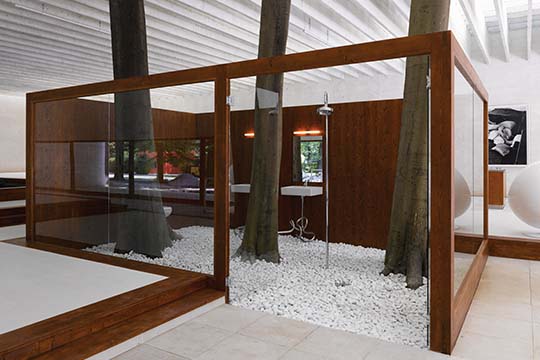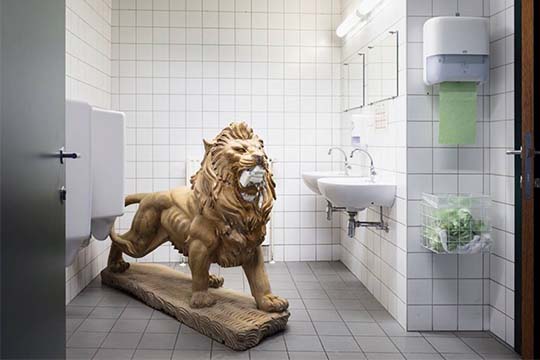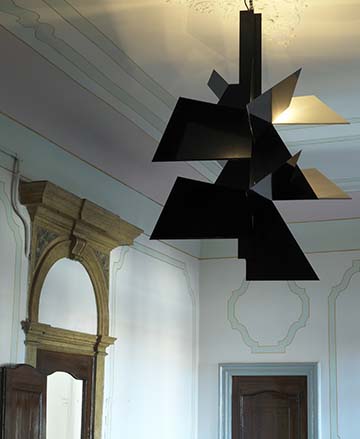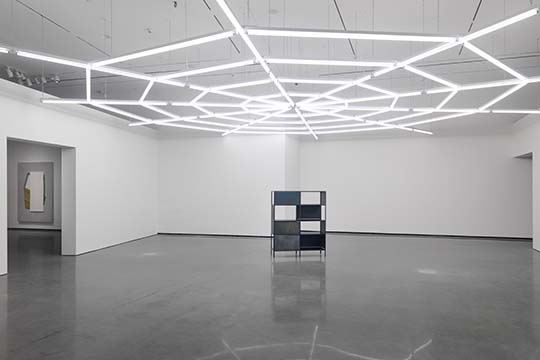Briony Fer: I’m delighted to be able to chair this afternoon’s conversation between these three artists. We’re in some ways expanding the notion of design to touch on architecture, but in a way, I think all of us might feel there’s a problem with the idea that art or sculpture might be about architecture? Are you as artists working with architecture design as a raw material, as a cultural material, as a literal, palpable material like any other? What is it that you’re doing with it?
I think it’s very interesting to bring you three together. In some ways, one can imagine certain overlaps perhaps, but you have such distinctive practices. I think one of the things that we’d really like to do is loosen up the categories—to think of sculpture in a more expanded sense, but also to think [about] what might go under the sign of architecture and design. I’d like to just ask each of you, even if we complicate this later, what it means for you if one’s going to say that you work with architecture.
Michael, can I start with you? Is that a meaningful or meaningless question?
Michael Elmgreen: As an artist, you can’t imagine not being dependent on space. You need to have a place to show your work, and, of course, space influences the way the audience perceives your work, the setting, the social context. Geographical location and the aesthetics of the architecture that surrounds you. [Ingar Dragset and I] started out with a practice—because we didn’t have any proper art education— that was questioning the format of the white cube, the standardized format of showing art because it looks more or less the same all over the world. We started questioning that until we found out that the art spaces are not going to change just because we questioned them. ... So I would say we put architecture on a survival course sometimes to see if it can survive our interpretation and our handling of it. And if it can get a new kind of identity or consciousness through how we treat it.
Fer: Nina?
Nina Beier: Well, it’s funny. I wouldn’t have consciously thought about architecture in a direct way to my practice, but I do think that all people who make sculpture rely on the language that has been produced within design and architecture, as well. But because we work in this field, we have the choice of either representing these existing tropes or borrowing from them, and it’s a constant negotiation of bringing these things in dialogue. I think it can be quite fruitful to think about [architecture] as the language that is shared between the fields.
 1. Elmgreen & Dragset. The Collectors, 2009.
1. Elmgreen & Dragset. The Collectors, 2009.
Fer: Martin?
Martin Boyce: I think sometimes when these associations are made, you instantly want to resist them, and as your practice develops, you become less conscious about what it is that you’re looking at. There may have been a time when it was clear that I was really drawn toward a certain language of the history of design and architecture, but as the practice develops, it includes so many things. And I think, really, I’m very interested in constructed landscape, and interiors and the psychology of interiors, and having an arrangement of objects or an arrangement of sculptural fragments you can build. You can create a cityscape, or you can create an archetype of space, like an urban park or a corporate lobby space through the introduction of specific objects or specific types of objects, and I think that’s where sculpture and space and architecture kind of collapsed together in my practice.
Fer: There have been moments in 20th-century art and architectural history where things must have felt much more certain, you know, that desire for unity that was the Bauhaus. This desire for a utopian totality that modernity or modern life could in some ways bring these different elements together. But something has perhaps come out of that, and that’s the idea that it was all a bit of a fiction. That [utopia] is imaginary. The mise-en-scène of the Bauhaus rather than pure form following function was as staged as anything else, and in some ways all your practices do speak to those sorts of fictional environments.
Elmgreen: I think we very much question certain tendencies in modernist architecture and design. Bauhaus had an amazing utopian vision of mass-producing furniture in materials that at that time were cheap leather and chrome and steel and so on. And what happened to it? Well, the Bauhaus’s furniture are luxury goods today, and not for their big working-class martyrs. Bauhaus housing is also very hard to live in, but very attractive for connoisseurs to own, and the idea of architecture at that time was ‘we know what the people need,’ as if we would have completely standardized needs in our everyday lives and routines. Fortunately, we’ve come to a certain point in our culture where we have to admit that we are quite diverse. We live in different ways with different desires. We have different dreams. We have different backgrounds, and therefore such standardized models are very difficult to work with in today’s reality, and that’s maybe where [Elmgreen & Dragset] come in and sometimes either mock or question or displace or alienate some of these truths of modernist design. And say, ‘hey, what if?’
Fer: Nina, perhaps yours is a practice that references architecture the least explicitly, but certainly the idea of the world of things, the world of props. Talk us through some of these images.
Beier: I worked with these guardian lions, and I like these objects because they are these [protectors] of the threshold between architecture and the outside—between the private space and the public space. And when we were talking about this meeting of architecture, design, and art, for me, this has been the object that has posed the most interesting attention of that field. When they arrived at my studio, they were placed outside in the back garden next to the trash bins, and they look fantastic there; they created this threshold; they brought the architecture with them when they were standing there. When they were picked up and brought on the van to the exhibition space, they looked amazing standing on the van, in the elevator. Every stage along the way, I was amazed at their ability to carry this power of the role that they were initially made for. And then the moment they made it into the exhibition space, they were just marble sculptures, and I couldn’t bring out their power. Now, I’ve just installed them in the outer spaces of institutions—the stairwell, the toilet, the kitchen—so now they’ve found this in-between space where they somehow hold onto [their power].
 2. Nina Beier. Guardian (detail), 2019.
2. Nina Beier. Guardian (detail), 2019.
Fer: A threshold that is not something fixed but mobile and is actually a psychosocial threshold as much as a literal built boundary between spaces. Martin, would you say that you’re also using the space of an installation … not referencing the built environment, necessarily, in an explicit way? …
Boyce: I think it comes and goes. There’s been times when there’s been very specific objects I referenced, and the social cultural history of those objects feeds into the work and can be unpacked in a way. And then there’s other works that become much more open and less specific and really functioned in a more poetic way.
Some years ago, I was living in Berlin for a short period, and I had a bit of time on my hands where I could really develop [a] project. I had come across this image of these four abstract concrete trees, which were made by the sculpture brothers, Jan and Joël Martel, and I just became really fascinated with this structure, and I began to take apart the tree and developed a repeat pattern based on the tree. I developed a typography that came out of the repeat pattern, and still to this day I have a pallet of shapes that come from the original trees that I use within the sculptural language of the work.
The image of the hanging chandelier was from an installation in Venice, and in the original palazzo, when we went to visit for the first time, there were these really gaudy Murano glass chandeliers hanging from the ceiling. On the plane back from seeing the space, two things occurred to me: I wanted to replace the Murano glass chandeliers with a sculptural equivalent, and I wanted to introduce autumn leaves into the rooms. My instinct was to somehow wedge one landscape into another—to bring this idea of a garden into an interior. And so when I went back to the studio, I had to figure out what this chandelier would be, and I took this model of the Martel tree that I had made, and I just inverted it. So, here on these pieces, you can see the repeat pattern that was developed from the trees.
 3. Martin Boyce. A Forest (I), 2009.
3. Martin Boyce. A Forest (I), 2009.
This is a ventilation grille piece. There have been many different iterations of the ventilation grille sculptures, and they are among the smallest works that I’ve made, physically, but when you install, say, five ventilation grilles throughout a series of rooms or even one room, then the whole architecture of the space becomes part of the work. And this is really interesting … you’re talking about the idea of thresholds in relation to sculpture, in relation to art and installation, because these pieces really became these thresholds between the interior spaces that we occupy in a building and the unseen guts of a building: the conduits and pipes and so on, that we were not party to in architecture but are going on around us.
Fer: Perhaps we can jump forward, Michael, to some of your work where you dramatize some of these differences between inside and outside. Could you say something about your interest in interiors?
Elmgreen: I mean interior design has had quite a bad reputation. The reality in our world today is a very few of us can actually afford to have an architect making our space. So, we have to express our identities and organize our lives on the inside. And therefore, I think an interior is a much more interesting cultural signifier than architecture is, because architecture is just the result of maybe a pretentious architect making his landmark in the middle of the city, whereas how we decorate our homes tell about our times today, our identity, our ways of living.
 4. Elmgreen & Dragset. The Collectors, 2009.
4. Elmgreen & Dragset. The Collectors, 2009.
When [Elmgreen & Dragset] were invited to do a pavilion [at the Venice Biennale]—actually, we were invited to do two pavilions because Ingar is Norwegian and I’m Danish [and those nations are neighbors]. We thought of these [pavilions] as domestic houses because they have somehow the scale of a villa or an embassy in a posh neighborhood. And in Venice, you also have this situation where everyone is competing [for] the prize, like winning the prize for growing the biggest pumpkin in your garden or something. So, [we thought] let’s make these into real domestic settings of collectors, because in private collections, the interior—the design of the house—is playing quite a significant role. The house might be shaped after the collection. The collection might also be shaped after how the house and the architectural settings are, and we wanted to highlight the fact that people actually collect [art] for all kinds of weird, insane reasons and not only as investment or market prices. ... But people also collect because of passions. So, we made these two houses of collectors in Venice … to give people a possibility to see artworks in a different setting. Sometimes, if you come into an exhibition, and you are in a typical white cube, I think the first thing that comes to mind is: is it a good artwork or is it art at all? And that’s so not interesting. I mean, it’s interesting what the artwork is telling you. What kind of message is it giving you? What is it doing to you? And … if you change the environment, if you erase the institutional framing and turn it into something else, suddenly you look at the art world in a way where you feel “oh, I can also sit down at the sofa or sit at the desk” and you look at the art world in a more personal way, not in such a hieratic-viewer situation.
Fer: I think the word in French for a show home is a maison témoin, a kind of ‘witness home.’ It has a kind of criminal air to it. In some ways, certainly in a work like this, Michael, you even scripted that kind of fictional life of your protagonist. And I think both Martin and Nina, you also imagine a viewer is a protagonist that enters into your scene, as it were. I wonder how you would see the viewer entering some of your installations. Martin, perhaps particularly in relation to that Eames work where you’re invoking Eames—you know, you have these precious modernist design objects interspersed with sculptures and other things that we live with. Could you describe what you’re doing with that Eames connotation?
 5. Martin Boyce. Between the Airport and the Beach, 2013.
5. Martin Boyce. Between the Airport and the Beach, 2013.
Boyce: I became really fascinated by these [Eames-designed] modular shelving systems, and also the matter of the Eames House itself; they both came about around the same time. And of course, they seem to represent, in such a very concise way, this idea of the transparency and democracy of the modernist project. But the more I began to look at them and think about them in relation to the present that I made them within, the Los Angeles that they now may occupy, in its own fictional sense, wasn’t the Los Angeles that they were born into. I was really interested in this more paranoid, dystopic kind of landscape that they might now be part of, and so I began to imagine this sort of parallel noir landscape that they might occupy.
In this case, for example … this sculpture is completely remade … but then I dusted the object in darkness. I wanted to see an object under bright light, but for it to look like it was in the dark. … All these strip lights [create an] uncomfortable kind of presence [by] using these off-the-shelf fluorescent lights to create the spider’s web. So, it’s really this idea of introducing an imaginary, parallel world.
The discussion is part of Nasher Prize Dialogues, the discursive platform of the Nasher Prize, the annual international prize for a living artist in recognition of a body of work that has had an extraordinary impact on the understanding of sculpture. The Dialogues are intended to foster international awareness of sculpture and to stimulate discussion and debate. Programs—including panel discussions, lectures, and symposia—are held in cities around the world on a yearly basis, offering engagement with various audiences, and providing myriad perspectives and insight into the ever-expanding field of sculpture.
1. & 4. Elmgreen & Dragset (b. 1961 and 1969). The Collectors, 2009. Danish and Nordic Pavilions, 53rd Venice Biennale 7 June–22 November, 2009. Photo: courtesy of the artists.
2. Nina Beier (b. 1975). Guardian (detail), 2019. Marble, soap, beard trimmings, 51.18 x 66.93 x 21.65 in. (130 170 x 55 cm). Installation view Housebroken, Kunsthal Gent, 2019. Photo: courtesy of the artist.
3. Martin Boyce (b. 1967). A Forest (I), 2009. Powder-coated aluminum, steel chain, electronic components, 72.83 x 49.6 x 49.6 in. (185 x 126 x 126 cm). Photo: courtesy of the artist.
5. Martin Boyce (b. 1967). Between the Airport and the Beach, 2013 (on the ceiling). When Now is Night, 2002. Photo: courtesy of the artist.